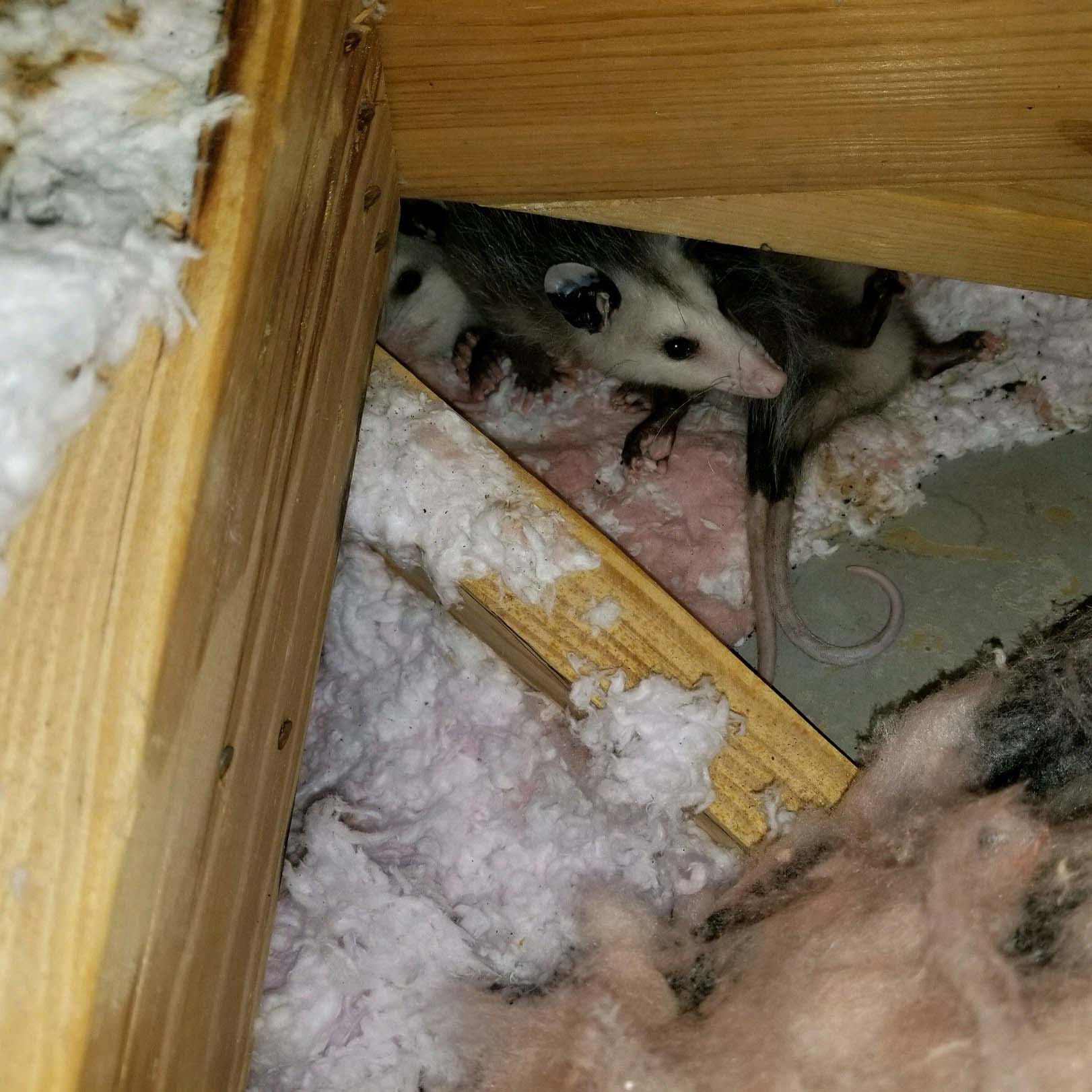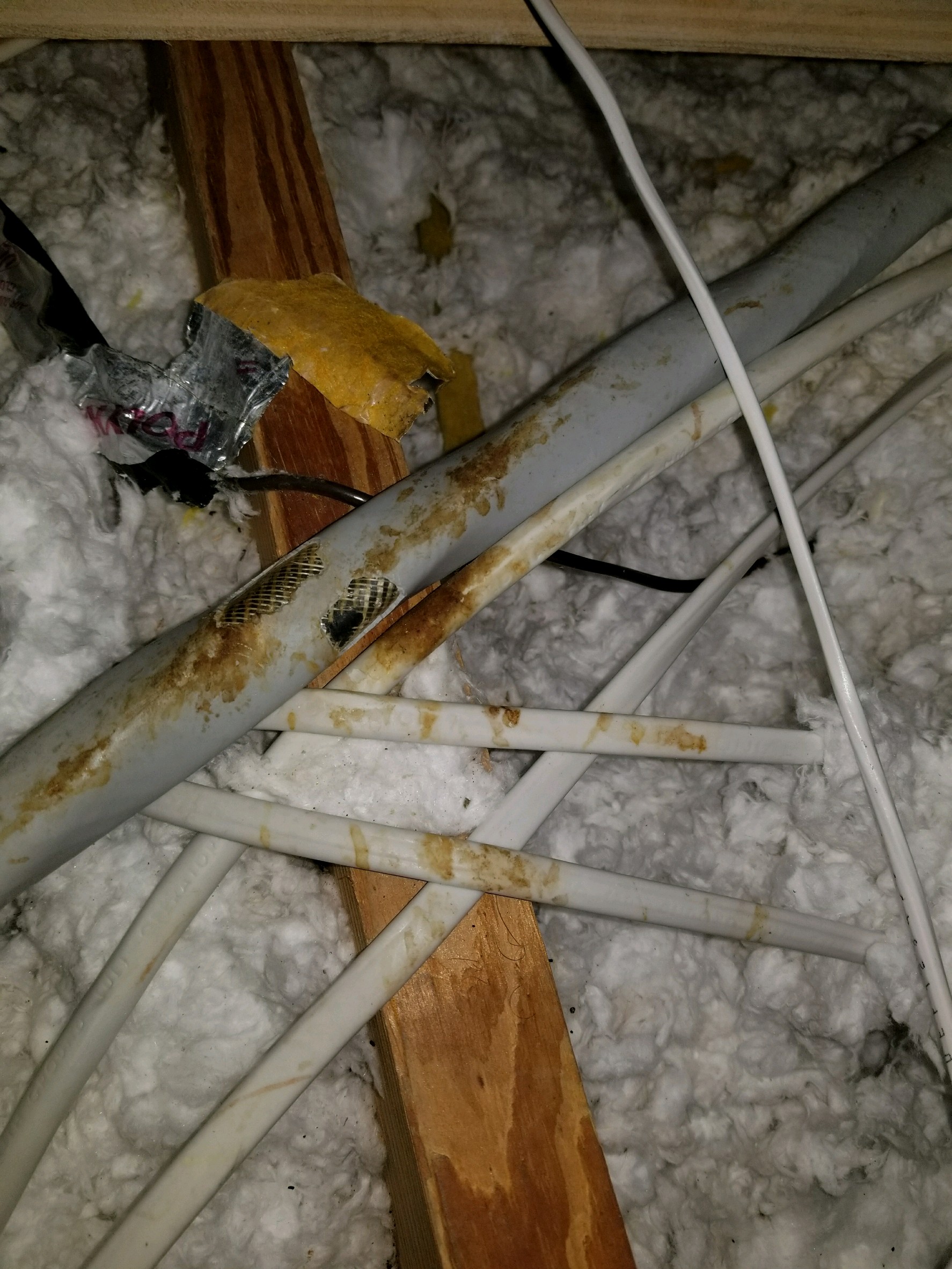Ever have an unwanted guest? The furry friends we love to see in nature can be the worst unwanted guest offenders - once they’re in, they don’t like to leave! What’s worse, animal saliva, feces, and urine can bring serious disease to your home, and their pheromones often attract other critters to your attic.
Coastal Wildlife Removal offers a complete attic remediation service, removing the old insulation and installing new insulation to the proper R-level. We’ll ensure your home stays your home.
How it Starts
Commonly during breading season, animals nest their young in the attic space to keep them protected from predators. We provide humane removal for the mother and it's young, and work with local rehabbers to ensure both the mother and young transition to the wild safely.
Health Hazards
When Raccoons and Opossums bed down in the attic space contamination can get out of control quickly. The buildup of feces can cause serious health and air quality concerns.
Energy Bills on the Rise!
Nesting areas are key areas for rats and mice to bed down and are focal points of contamination. Insulation and HVAC ductwork can be damaged in the creation of these spaces. This activity not only causes a bedding ground for bacteria and diseases in your insulation, but also diminishes the insulation’s R-Value, which can substantially increase your monthly energy bill.
The Solution
Coastal Wildlife Removal’s attic remediation service removes all contaminated and diminished insulation. By replacing contaminated insulation, we remove any pheromones that may attract future populations from reentering your home.
Quality, done right
During attic remediation, not only do we remove any source of contamination, we also restore an appropriate R-value to your attic to ensure excellent energy efficiency. As shown, when the attic is properly insulated, you will not see any exposed joists.
As we all know, personal hygiene is not a rodent's strong suit. While traveling through all the nasty areas they encounter, they build up a coating of grease in their fur. When rodents travel along plumbing pipes, electrical lines, or other areas, they will leave behind grease trails as shown above.
We do it all!
Our attic restoration process eliminates all risk of disease transmission from animal waste and/or infected attic insulation. We dispose of all hazardous and toxic infected materials, and treat the entire attic space for infectious bacteria, viruses, and fungus, so that you can enjoy freedom from worry about your family contracting any of the dangerous and often life-threatening diseases carried by raccoons, opossums, rats, and many other animals. After disinfecting the entire attic and removing the ruined insulation, we replace it with new fire-retardant cellulose insulation.
DISEASE TRANSMISSION
The many species of Florida wildlife carry a host of diseases that can be transmitted to humans. These include bacterial and fungal infections, which may become airborne and spread about your home through an attic infestation. Animals get into spaces where air flows and often open up ductwork, enabling the diseases borne in their feces, urine, and saliva to spread throughout the home. Among the more commonly carried diseases are the following.
Rabies
IF YOU HAVE BEEN BIT BY A RABID ANIMAL, PLEASE SEEK IMMEDIATE MEDICAL ATTENTION!
Rabies is a viral infection caused by a bite or scratch from an infected animal, including raccoons, dogs, bats, and skunks. The virus infects the central nervous system, causing neurological damage, brain damage, and death.
Initial symptoms can easily be confused with those of the flu, consisting of fever, headache, weariness, and general discomfort. If untreated, symptoms will progress to include brain dysfunction, anxiety, delirium, and hallucinations. Once clinical signs appear, the disease is almost always fatal, which is why it's important to receive immediate treatment if you suspect that a rabid animal has bit or scratched you.
Baylisascaris
An infection, transmittable to humans and pets, caused by a roundworm carried by raccoons. Baylisascaris is transmitted to humans by ingesting the eggs contained in raccoon feces. The eggs hatch into larvae inside the human host's digestive tract, from which point they move throughout the body affecting muscles and organs, the brain and spinal cord, or the eyes. Symptoms include:
Left: B. procyonis egg, showing the developing larva inside. Right: Larva of B. procyonis hatching from an egg. Credit: DPDx, U.S. Fish & Wildlife Service
Loss of muscle control
Nausea
Liver enlargement
Loss of coordination and focus
Fatigue
Blindness
Coma
Leptospirosis
Also known as rat fever, Leptospirosis is a bacterial disease caused by Leptospira bacteria and spread through the urine of infected animals, especially rats and mice. It can present with a wide range of symptoms, and can lead to kidney damage, liver failure, meningitis, respiratory problems, and even death. Symptoms of leptospirosis include:
Nausea
Headache
Red eyes
Muscle aches
Rash
Jaundice (yellow skin and eyes)
Chills
Diarrhea
Fever
Toxoplasmosis
A single-celled protozoa called Toxoplasma gondii causes this disease, usually through ingestion of the tiny particles of feces of an infected animal. It can present with flu-like symptoms or with no symptoms at all, as it can be kept in check by a healthy immune system. Children, pregnant women, and the elderly are particularly vulnerable to toxoplasmosis, which can cause serious damage to the brain and to the eyes.
ANIMAL pheromones
Pheromones are naturally occurring chemical secretions that trigger a response in other animals of the same species. Pheromones are used to communicate between two animals or among the entire group or colony of insects, mammals, and most other animals. Types of pheromones include:
Alarm pheromones: A volatile substance secreted in response to a predator or threat. This can trigger either flight (all the animals fleeing) or group aggression (teaming up against the perceived threat).
Releaser pheromones: Powerful, fast-acting molecules that trigger an attraction in other members of the same species, from a distance of up to 2 miles away. These can be used to attract a mate, or for a mother to attract her young to feed them.
Signal pheromones: Used to instigate short-term behavioral changes in another animal, such as rats using the GnRH signal pheromone to initiate mating displays in other rats.
Territorial pheromones: Potent deposits of an individual animal's pheromones used to mark the boundaries of their territory. The presence of territorial pheromones can either ward off other animals or instigate a confrontation over their turf.
Trail pheromones: Commonly found in wasps, ants, and other insects, these pheromones indicate routes of travel taken by the colony to find safe shelter, food sources, or ideal locations for mating.
From start to finish, you can count on Coastal. Call now to speak with a Wildlife Specialist.










